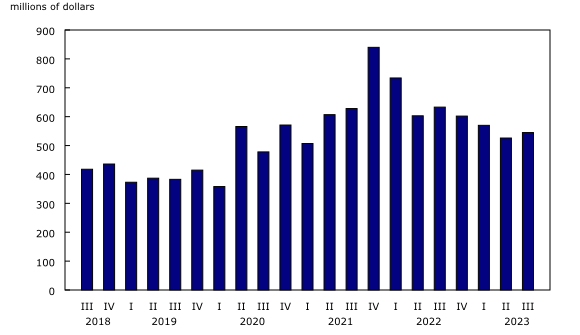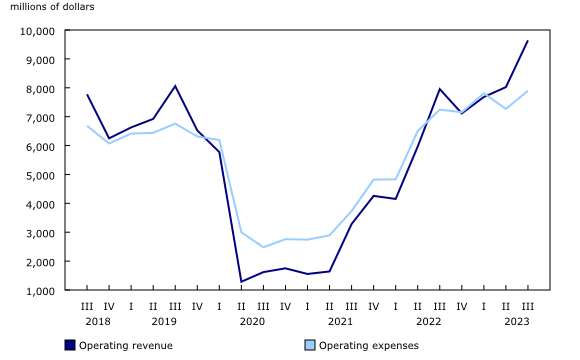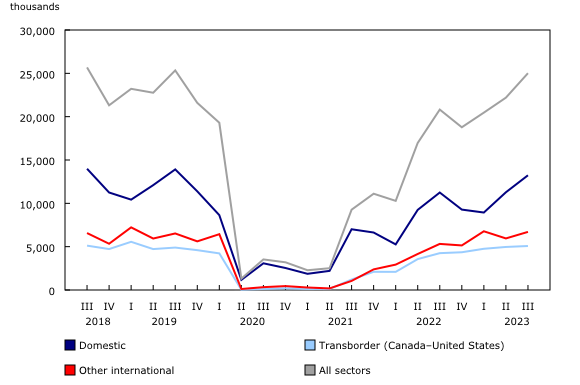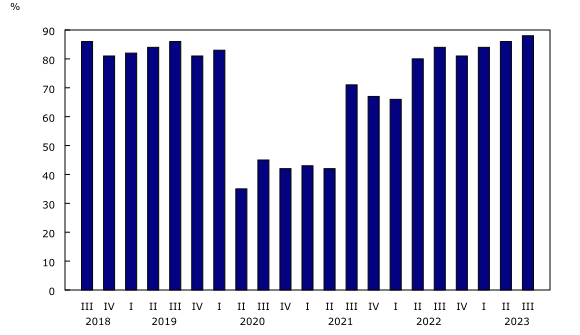Quarterly civil aviation statistics, third quarter 2023
Released: 2024-02-19
Highlights
Operating revenue for the 24 largest Canadian air carriers totalled $9.6 billion in the third quarter, a sharp increase by 21.2% from the same quarter of 2022 and by 19.7% from the third quarter of 2019, before the COVID-19 pandemic.
At $8.7 billion, passenger revenue remained the main revenue source for airlines in the third quarter of 2023, while air cargo generated $544.6 million in revenue.
In the third quarter, Canadian carriers transported 25.0 million passengers on scheduled and charter services.
Operating revenue continues to rise
During the third quarter, operating revenue for the 24 largest Canadian air carriers (Levels I and II) totalled $9.6 billion, 21.2% higher than in the third quarter of 2022 and 19.7% higher than in the third quarter of 2019.
In the third quarter of 2023, passenger revenue, at $8.7 billion, represented 90.2% of total operating revenue, slightly higher than the 89.4% share in the same quarter of 2019. Cargo revenue reached $544.6 million in the third quarter of 2023, up from $382.7 million in the same quarter of 2019. It represented 5.6% of the total operating revenue in the third quarter of 2023, returning to the 5% to 7% revenue contribution observed prior to the pandemic.
Furthermore, total operating expenses were $7.9 billion in the third quarter, 9.0% higher than in the third quarter of 2022 and 16.8% higher than in the same quarter of 2019.
Other operating expenses, such as depreciation and maintenance, accounted for the largest share (48.8%) of total operating expenses in the third quarter of 2023, followed by turbo fuel (27.7%) and wages, salaries and benefits (20.0%).
Passenger volumes climb
The 24 Canadian air carriers transported 25.0 million passengers in the third quarter, of whom 24.5 million were on scheduled flights and 508,000 were on chartered flights. While this represents an increase of 20.2% from the same quarter of 2022, it was 1.3% lower than the pre-pandemic level reported in 2019.
In the third quarter of 2023, there were 13.2 million passengers on domestic routes and 11.8 million international passengers, or 47.1% of the total, similar to pre-pandemic levels. Among the international passengers, 5.1 million had taken transborder flights (between Canada and the United States) and 6.7 million were carried on other international flights.
Scheduled (non-charter) traffic was 65.5 billion passenger-kilometres in the third quarter, while capacity was 74.0 billion available seat-kilometres, resulting in a load factor of 88.4%. This is above the 85.7% load factor of the same quarter in 2019, when there were 66.4 billion passenger-kilometres and 77.5 billion available seat-kilometres.
Did you know we have a mobile app?
Get timely access to data right at your fingertips by downloading the StatsCAN app, available for free on the App Store and on Google Play.
Note to readers
With this release, data pertaining to air cargo operating statistics including goods revenue, goods carried, goods tonne-kilometres, total tonne-kilometres, available tonne-kilometres, weight load factor, and tonne-kilometres flown per employee have been revised back to the first quarter of 2016. This is the result of revisions to survey data.
This release covers Canadian Level I and II air carriers. Because of the impact of the COVID-19 pandemic, no air carrier level changes were applied for reference year 2023.
Level I air carriers include every Canadian air carrier that, in the calendar year before the year in which information is provided, transported at least 2 million revenue passengers or at least 400 000 tonnes of cargo.
Level II air carriers include every Canadian air carrier that, in the calendar year before the year in which information is provided, transported (a) at least 100,000, but fewer than 2 million revenue passengers, or (b) at least 50 000 tonnes, but fewer than 400 000 tonnes of cargo.
Net non-operating income and loss are from commercial ventures that are not part of the air transportation services, from other revenues and expenses attributable to financing or other activities that are not an integral part of air transportation, and from special recurrent items of a non-periodic nature. Provision for income taxes is also included. Non-operating income can be, for example, capital gains from the sale of aircraft, interest income and foreign exchange adjustment, while non-operating expenses can include capital losses and interest on bank loans and other debt.
Data in this release are not seasonally adjusted.
This release also includes data for the second quarter of 2023.
Because of rounding, components may not add up to the total.
Contact information
For any questions pertaining to this revision, please contact statcan.transportationstatistics-statistiquesdutransport.statcan@statcan.gc.ca.
For more information, or to enquire about the concepts, methods or data quality of this release, contact us (toll-free 1-800-263-1136; 514-283-8300; infostats@statcan.gc.ca) or Media Relations (statcan.mediahotline-ligneinfomedias.statcan@statcan.gc.ca).
- Date modified:





